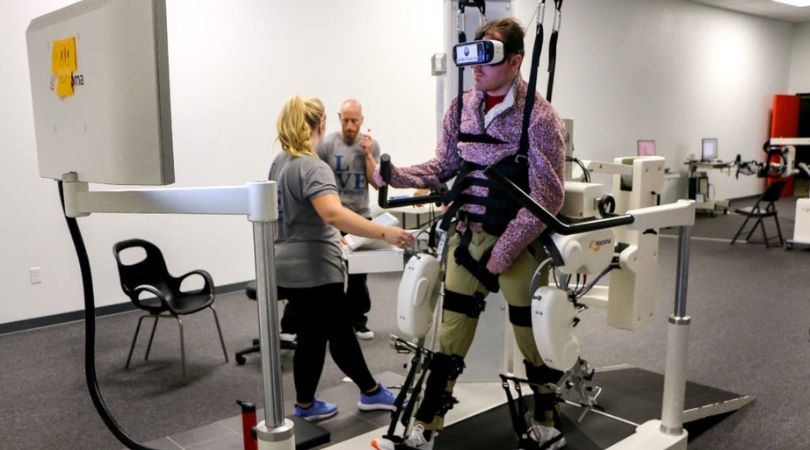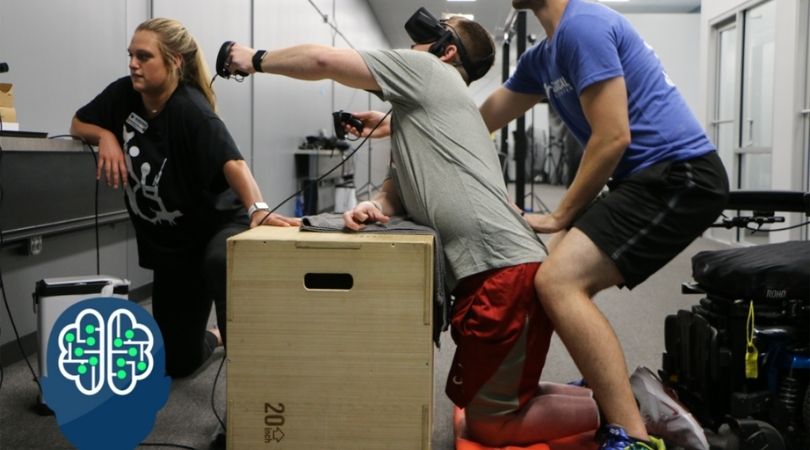
DreamHack, the esports and gaming lifestyle convention held across the world came to Dallas at the beginning of June. The three-day 24-hour convention had a lot to offer including music, competition, cosplay, and a hall of vendors and organizations that share an intersection with gaming. While we walked the expo hall one booth stood out, Neuro Rehab VR. Based out of Fort Worth, Texas, the company running the booth specializes in utilizing VR in physical therapy rehabilitation centers. Something, that although makes total sense, had never crossed my mind. As I got to speaking with Henry Weber, Business Development, Marketing & Sales, I knew that I wanted to highlight them when the convention was over.
Weber was gracious enough to answer a few of our questions and give us more information on how Nuero Rehab VR puts a gaming device to work in a space of recovering and therapy.
But Why Tho: How did Neuro Rehab VR start?
Henry Weber: Neuro Rehab VR started when Bruce Conti, owner of the Neurological Recovery Center in Fort Worth, saw the potential in utilizing virtual reality for his patients. He then found Veena Somareddy with the expertise in virtual and augmented reality development and together co-founded Neuro Rehab VR to begin developing the technology and applications to be used as a supplemental tool to patient’s therapy plans.
But Why Tho: We met at DreamHack Dallas, a convention focused on eSports and gaming lifestyle, why did you think it was important to attend the event?
Weber: As a Fort Worth based company, we are always looking for events in the Dallas-Fort Worth area to bring more exposure to our company and connect with locals who may be interested or able to assist in our company’s growth. Though we knew we weren’t going to find much of our target audience and customers in physical therapy at DreamHack, we thought it was important to showcase to the gaming community our innovations and utilization of virtual reality and gaming techniques for healthcare and physical therapy. Gamification is a big component to our virtual reality physical therapy exercises, but it also provides a more fun and engaging experience to therapy for patients.
But Why Tho: I’ve seen the use of other gaming devices, specifically the Wii, in Rehab centers, what is unique about using VR as opposed to other methods?
Weber: You can find the Wii being utilized in many rehab and physical therapy centers around the country. Virtual reality is the next generation of rehabilitation and may be comparatively the next best upgrade from the Wii for therapy practices. The difference is the virtual reality is completely immersive, which provides a more engaging and focused experience in doing therapy exercises.
For a lot of patients, it may be their first time doing virtual reality anything and they get excited after trying it because it is something they have never done before. A lot of patients now look forward to coming back for their VR therapy treatment, instead of possibly dreading the monotony of their traditional therapy. We have also seen patients have a tendency of forgetting about their conditions and will reach and walk around more than they would typically feel comfortable doing in the real world.
Inside the virtual reality environments, we can 100% control the environments and the interactions the patients have to make. Our technology, unlike the Wii, also allows us to track, measure, and quantify patient progress with the real-time data we receive for each exercise.
But Why Tho: What kinds of rehabilitation does the VR rehab target?
Weber: We have commercialized our technology into our FDA registered product XR Therapy System, designed for the in-clinic use of virtual reality physical therapy. With that being said, we target hospital rehabilitation departments, outpatient physical therapy, and neurological rehabilitation centers. Our exercises initially designed for the stroke, spinal cord injury, traumatic brain injury, and multiple sclerosis populations have now expanded and been updated to be utilized for all various forms of physical and cognitive therapy. We have also developed applications for children on the autism spectrum along with pain, anxiety, and distraction interactive experience.

But Why Tho: Is there a learning curve to using the equipment? Especially for older clients?
Weber (Nero Rehab VR): When a facility acquires our XR Therapy System we will go to their location to set up and provide an in-service for the therapists and staff to fully understand how to operate the technology and the use the exercises developed. The biggest learning curve is for the therapists to understand how and when to administer the technology, while we have thoughtfully designed our product and application to be very streamlined and easy to use for non-tech savvy people with less than a minute of setup time.
When it comes to the patients themselves, there is no limit to having fun. We have patients as old as 92 and as young as 5 utilizing the virtual reality during their therapy plans. Typically the physical therapist will make the decision if they think the patient would be receptive to the technology and would like to try it out. Most often they don’t mind trying new things and end up having a new fun and engaging experience.
But Why Tho: What has been the biggest obstacle in getting clinics to adapt to the new technology?
Weber (Nero Rehab VR): The biggest obstacle has been the clinics’ reluctance to trying new technology and long hospital system budget and sales processes. That is why we are simultaneously working with universities and other researchers to conduct clinical trials on all our exercises to prove their efficacy and to help with the adoption rate of medical professionals utilizing virtual reality in their practices.
But Why Tho: How many clinics are you in? Are there plans to expand?
Weber: Currently we are in three clinics utilizing our XR Therapy System as part of their patient’s daily therapy plans. Our system is also being used inside several universities and facilities for clinical research trials. The XR Therapy System is currently available for any facility wishing to acquire it for their own use and we would love to get in contact and speak with you. Our plan is to get our XR Therapy System into many more clinics around the country by the end of 2019 and more in the future.
But Why Tho: What are some goals that the company has?
Weber (Nero Rehab VR): Our mission is to provide the most efficient, enjoyable, and cost-effective care to people who need physical therapy and neurological rehabilitation. Our goals are to expand our product line into an at home therapy solution where individuals can continue their therapy exercises from the comfort of their own homes. The at-home Neuro Rehab VR headsets would give doctors the ability to monitor their patient’s exercises and progress remotely, but also allow patients who can’t afford to go to a therapy clinic a new way to keep up with the therapy they need. We hope that virtual reality starts to become a new mainstream and multipurpose solution for many individuals therapy needs in-clinic and at home.
But Why Tho: Thank you so much for taking the time to talk with me, Henry. Oh! One last thing, if anyone would like to get involved in any capacity or how they can find you all?
Weber (Nero Rehab VR): They can find us at NeuroRehabVR.com if anyone is trying to reach us for more information or to receive a custom proposal, they can reach out to us at [email protected].
When it comes to gaming, we’re often quick to shun it as a detriment to our health, but as technology advances, like the Wii and now VR, it’s a tool to help us recover too. If you would like more information on Neuro Rehab VR, check out their website.






